Canada A BUCKET LIST OFFSHORE ADVENTURE
Words & Images by Grant Dixon
(PART 1)
It was a bucket list trip of a lifetime – heading to Canada to fish for salmon, halibut and sturgeon – that got off to a less than auspicious start.
A month or so out Tony and Bea from Offshore Adventures got a phone call from Peregrine Lodge, our original destination: “Sorry we are closing early for the season so won’t be able to accommodate your guests. We will give you your money back.”
Tony and Bea were holidaying in Hawaii at the time and suddenly they had a potential disaster on their hands with six clients now ‘lodgeless’. Being the consummate professionals they are, after ringing around they managed to find a slot with a Tofino, Vancouver Island-based guide Rob Frawley who operates Lucky Strike Charters. Unfortunately, he could only accommodate three – Mike Baker, Paul Davies and myself.

These two halibut, at 126 and 125cm respectively, just snuck in below the upper size limit of 126cm plus.
Recently I compiled a feature on making the most out of your charter. Now was the time to put this into practice, first speaking to my fellow anglers as to what they would like to achieve and see before conveying this to Rob.
We all consider ourselves competent anglers running our own boats. We were keen to learn as much as possible about the fishery and to be fully involved in the fishing process, so how did we convey this to Rob without sounding arrogant or boastful? We were well aware that most of Rob’s clients would be American anglers who in my opinion are either very good or very bad. Many are happy to have the rod handed to them once the crew have done all the work and hooked them up – we didn’t want that.
The best way was to be upfront with our guide, telling him, “We don’t necessarily want to catch lots of fish or the biggest fish, but we do want to experience the fishery as a whole and want to be fully involved in the fishing process once we had proven we were capable.” It set the tone for the trip with Rob delivering in spades, but there was more drama to come before we even set foot aboard Lucky Strike – Rob’s twin Mercury Sea Pro-powered Grady White 232.
Getting to Vancouver’s domestic airport in plenty of time for the short flight across to Tofino, our small band of anglers were in high spirits with anticipation levels to match. It didn’t take long for that bubble to burst. Flying above Tofino a thick bank of cloud separated us from our destination and after circling around for 30 minutes or so trying to find a break, the call was made to return to Vancouver where a mad dash involving taxis, a ferry and more taxis began.
Getting to the ferry terminal through the heart of the city was a bit of a mission but once on board we could relax a little until we reached the island at around 6.30pm where we had to find a way of getting to Tofino, a three-hour plus road trip away. A seaplane flight was out of the question and the last bus had left an hour previously, so we spoke to a young taxi driver whose eyes lit up at the thought of such a lucrative fare. We settled on CAD$600 (NZD$750) for the trip (plus a tip) – a big number but we were desperate as fishing kicked off at 6.30am the next morning.
We were greeted on the dock by Rob with freshly brewed barista coffee and breakfast pastries which we enjoyed as we headed out to the salmon grounds, a 45-minute ride away, and made our plan for the day.
Fishing for salmon using downriggers was familiar territory for both Paul and I as we run them when targeting trout in Lakes Taupo and Tarawera. What varied greatly was the way they were deployed. The Canadians tow large ‘flashers’ that spin on a short dropback – 5’5” on average. The shorter the dropback, the greater the whip action of the flasher. The further back it is run, the slower the flasher action. Rob explained the colours of the flasher vary considerably with the seasons. In early spring when the algae bloom, bright colours, especially turquoise, red chrome and chartreuse are the go, changing as the season progresses to golds and blacks as the fish get darker pre-spawning. A good ‘go-to’ colour is red chrome.
The lures – mostly metal spoons or skirted ‘hoochies’ – are attached at precisely 36-42” behind the flasher, which is spinning in a wide arc, apparently imitating a feeding salmon. Whatever the theory, it evidently worked as by the end of the day we had our boat limit of eight chinook (two per person including the skipper) with a stray coho added to the mix. Back on the dock these were checked and documented by a fisheries officer who also took out the otolith (ear) bone as part of a management regime. With the paperwork done, the fish were sent to the cannery where they were smoked and canned and will eventually make their way back to NZ.
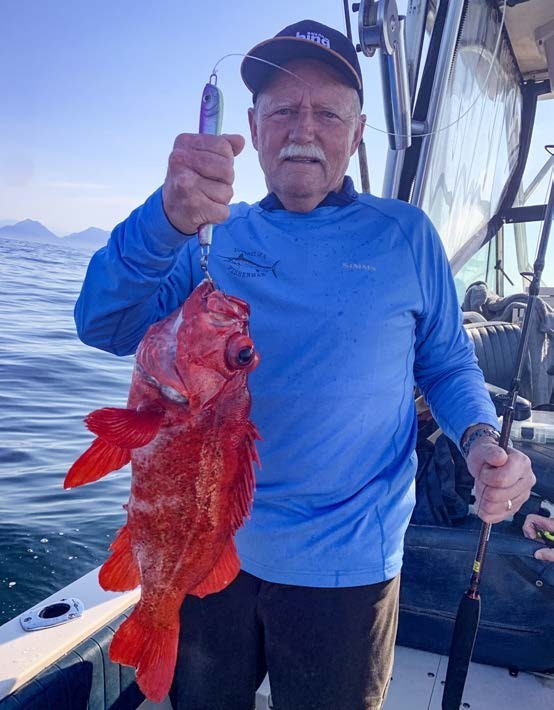
1) Paul with another of the rockfish species encountered – in this instance a vermillion rockfish.
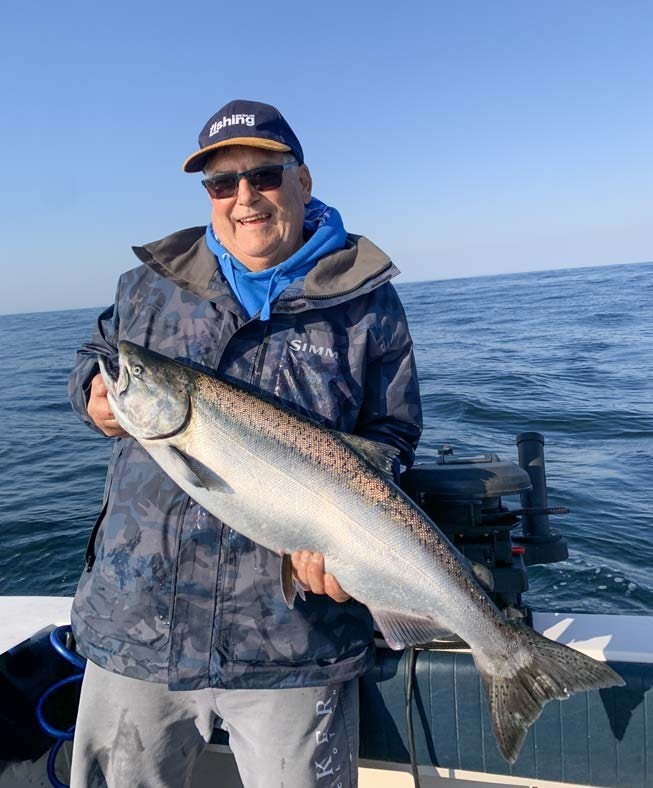
2) The writer with his best salmon of the trip.
The salmon trolling technique was ‘the same only different’, as previously mentioned. Rob runs two electric downriggers, one off either gunwale and typically these are deployed to 30-50 feet. The standard stainless steel wire cable has been replaced with 250lb braid attached to an 18lb ball. Rob says this eliminates any springing on the spool creating over-runs or burrs and is much more userfriendly.
One-to-one ratio mooching reels – Rob runs Canadian handcrafted Islanders which are a pleasure to use, especially when you remember to keep your fingers out of the way of the handles on a hard-running fish! – are matched to 10’6” (3.2 metre) purpose-built Shimano rods. The mono is 40lb test.
Canada’s fishery is highly regulated with obligations on the anglers to report their catches along with basic details such as when, where and how big (length). In the season there are 15 charter operators out of Tofino and these are almost all owner-operated. Rob fishes around 120-130 days for the season which runs from April through to September.
Chinook and coho are the main two species and there is a pink salmon run every other year. Sockeye are far less abundant.
There are quite strict regulations as to when and where you can fish and these can be something of a moving target. The fishery for certain species can be shut down with a day’s notice. There are areas and sub-areas within a fishery that can have different rules such as the non-taking of hatchery fish. If you thought the Marlborough Sounds blue cod rules were hard to follow, the Canadian regs are five-fold more difficult!
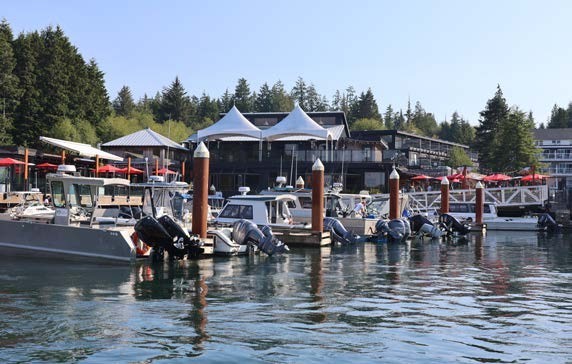
3) The marina at Tofino. Our accommodation and a restaurant was 50 metres away from where the boat was berthed.
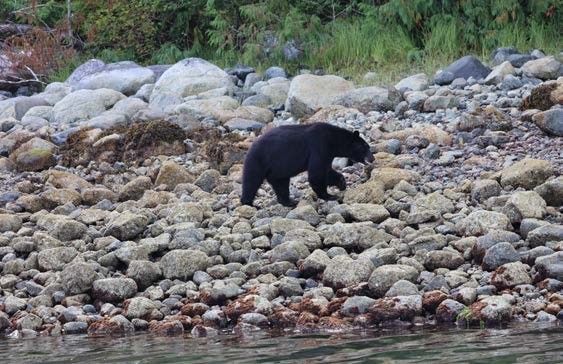
4) One of the highlights of the Canadian trip was the proliferation of wildlife. A bear forages for seaweed and crabs along the shoreline.

5) Another rockfish species falls victim to a softbait.

6) A Fisheries officer checks our catch as well as taking DNA samples to determine its origins.
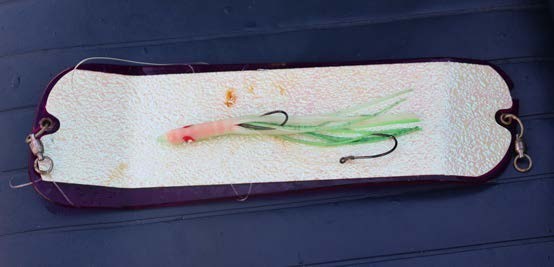
7) Hoochies were a favourite lure for salmon, run on a short leader behind the teasers.
Penalties for breaking the rules are tough. As an example, there is a requirement that all hooks be barbless to aid the safe release of unwanted fish. If caught fishing a barbed hook the fine is CAD$585 per barb – if you are fishing trebles that would be CAD$1750 (NZD$2188)!
I suggested that the fishery seems well managed, with Rob commenting that often the data would be flawed and inaccurate, resulting in some fisheries being shut down unnecessarily. The info was gathered dockside and from angler’s reports, extrapolated out by aerial survey number – hardly an exact science.
Fisheries managers compute run forecasts, the catch being divided up between commercial, First Nation and recreational anglers – sound familiar? While it might on the surface seem an equitable arrangement, like our Quota Management System there are flaws and it is open to abuse. First Nation commercial fishers get certain advantages such as heavily subsidised fuel – hardly a level playing field.
With day one under our belt and our salmon sorted, halibut were the next target species. Like many species worldwide, you will find these guys where there is a bit of current running. The Canadians target them with what they call spreader bars – a stainless steel device that separates the sinker from the bait via an arm. Only one bait per spreader rig is allowed and the hook must be barbless.
Salmon and octopus are the halibut’s chow time favourite and we were targeting them in 30-40 metres depth using Penn jigging rods combined with Penn Fathom II 30 and 40s spooled with 100lb braid – take no prisoners stuff.
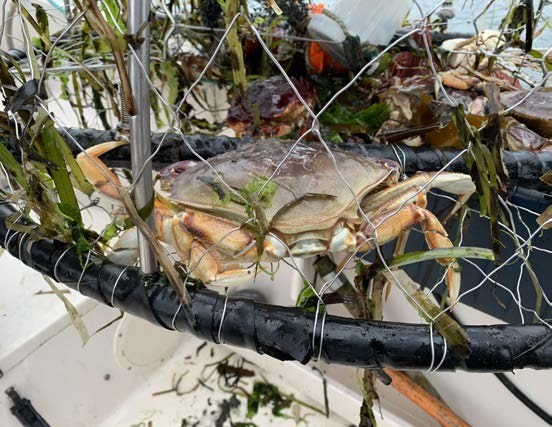
8) Fresh Dungeness crab were one of the culinary highlights of the trip.
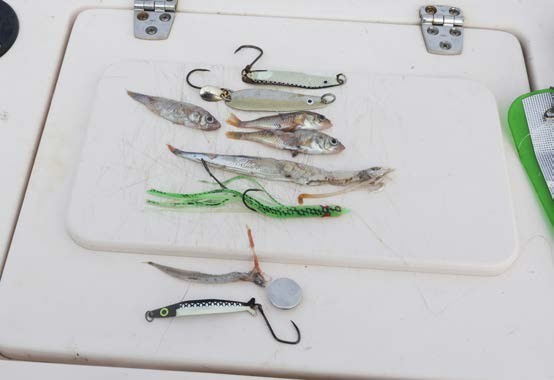
9) Matching the hatch. The lures we were running alongside content from salmon stomachs.

1) Along with halibut, salmon were a prized catch.
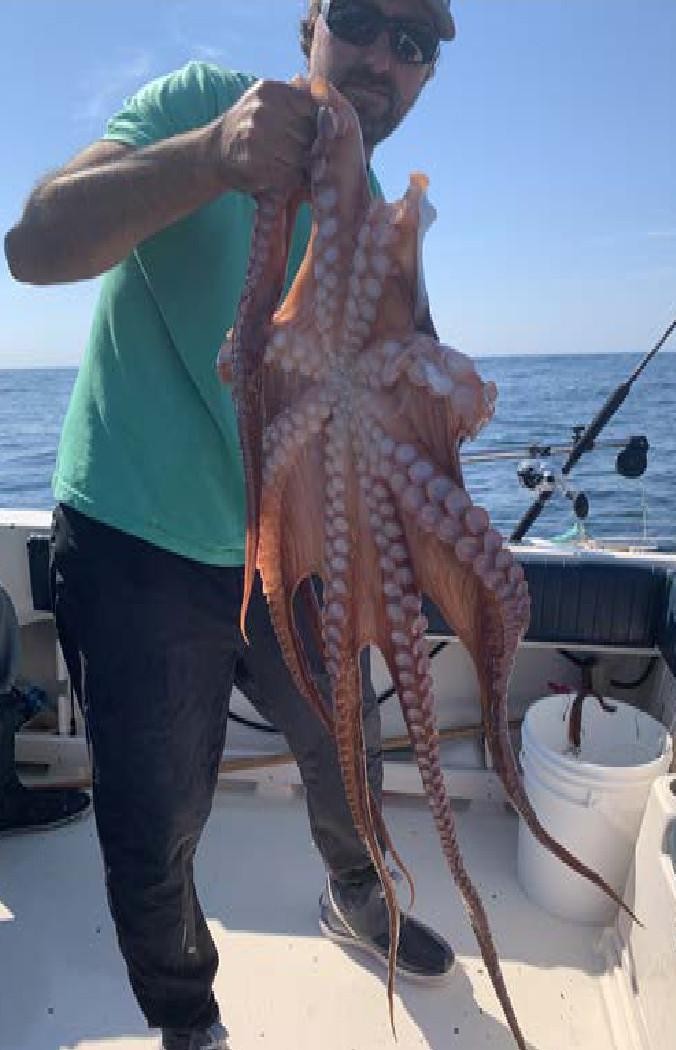
2) This octopus took a liking to a halibut rig. They are not only great eating but much sought after bait.

3) A prime salmon that fell victim to the Hoochie skirted lure run on a downrigger.
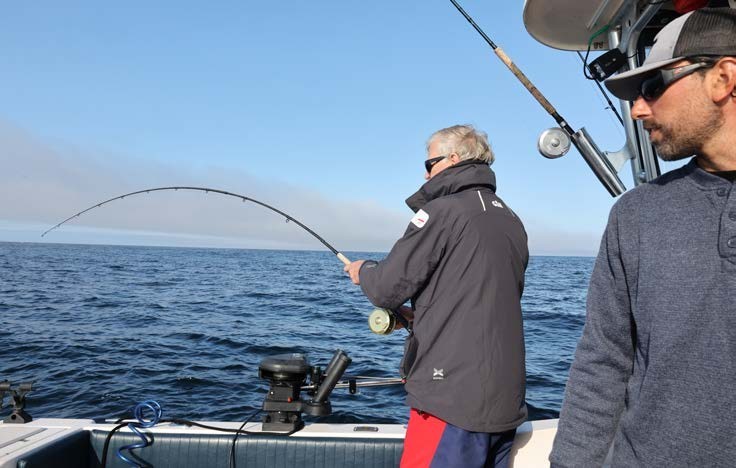
4) A typical salmon ‘mooching’ rod – Mike hooked up.
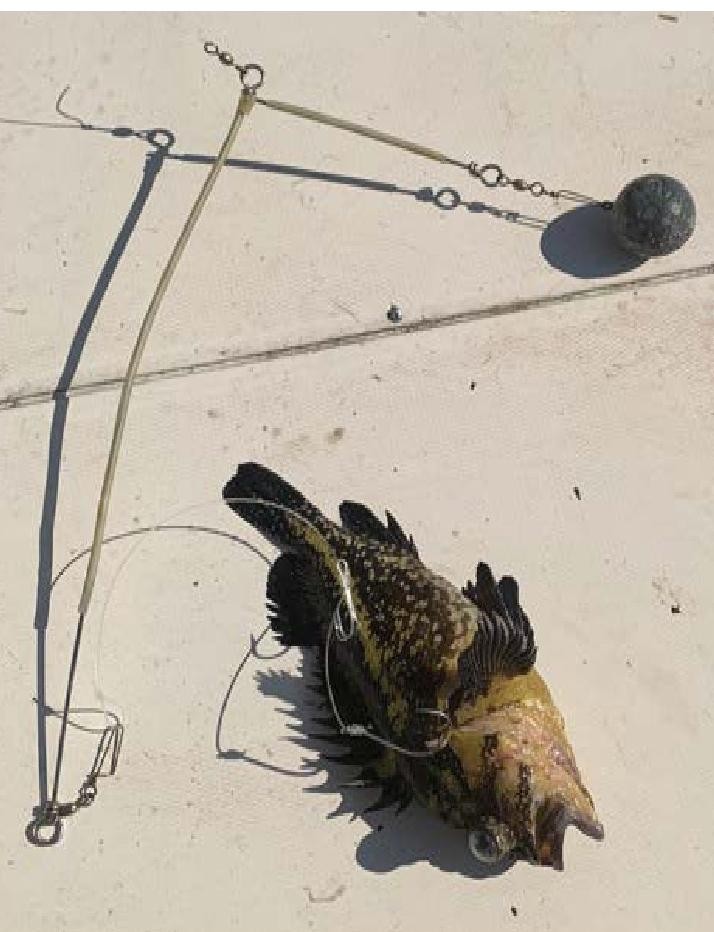
5) The standard halibut bottom bashing terminal tackle.
As part of that species’ management, recreational fishers can only take halibut that come under a 126cm upper size limit. The guidelines are set by the IPHC (International Pacific Halibut Commission) which determines the annual TAC (Total Allowable Catch) and the length of the season potentially runs from mid-February through to mid-November.
We – and I use that term loosely – came up with the goods. Firstly Paul tested the tape with a 126cm fish which was right on the money, to be followed closely by Mike’s 125cm effort. Both fish gave a good account of themselves, pulling plenty of string before finally being subdued. They didn’t come easily.
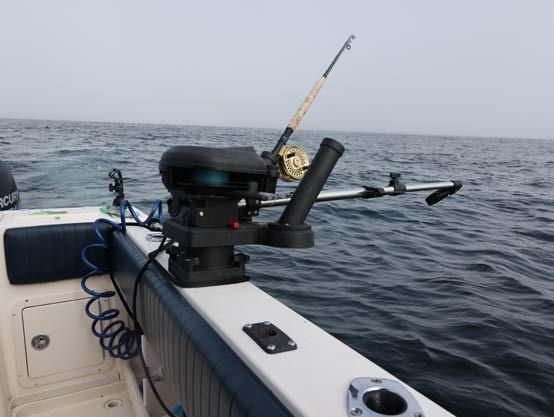
1) Downriggers were an integral part of the salmon trolling operation, often run stacked with two lines.
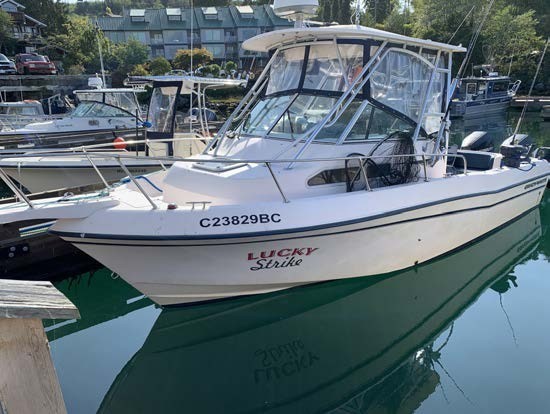
2) Rob’s charter boat Lucky Strike, a well-appointed Grady White.
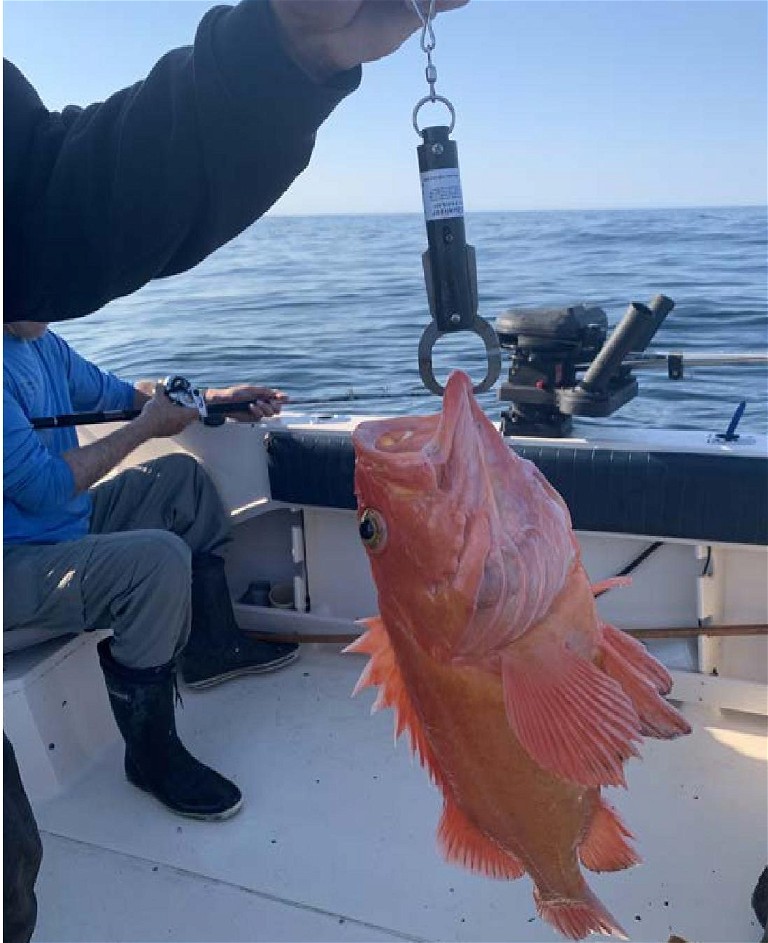
3) It is mandatory to carry a descending release device to return unwanted fish as safely as possible.

4) This lingcod, a member of the greenling family, headed the list of desireable bottom species..
I had packed a Shimano Twin Power 4000 spin reel and a fourpiece 5-10kg travel rod on which I deployed a variety of jigs and softbaits and while I might not have caught the biggest fish of the trip, I would have accounted for the greatest variety. A popular and agressive bottom fish is the lingcod, a fearsome-looking critter that is found throughout the fishery and makes for great eating. And there are a great many species of rockfish including yellowtail, yelloweye, vermillion, quillback, copper, black, and China, looking like smaller, colourful hapuku. The season for these runs from April 1 to November 15 and there are reserves where rockfish cannot be targeted. Rob says the Canadian government is aiming to have 30% of the coastal fishery locked away in reserves by 2025 – another ugly parallel with NZ.
Every boat must carry an approved descending device, in Rob’s case a SeaQualiser which can be set to a pre-determined depth at which a pressure-activated release gives the fish its freedom.
Days one and two proved to be the best of the Tofino leg. A front rolled in which produced an uncomfortable swell, confining our efforts to more sheltered inshore waters. We got to see a little of the wildlife those two days, the highlight being a bear feeding at the water’s edge, turning over boulders to expose the crabs and seaweed below.
We checked out a salmon farm with Rob explaining the issues which surround them including the spread of lice and diseases such as mouth rot and jaundice to the wild population. The fisheries managers allow a lice count of three per fish and anything over that sees the farm managers having to undertake a delousing programme.
Our trip to Tofino had been a huge success from several perspectives. Guide Rob had gone the extra mile for us, ensuring we got to tick off as many of the boxes as the conditions allowed. We got to enjoy some great fishing with Rob’s insights and commentary giving us a better understanding of the fishery.
Next month – targeting sturgeon among the skyscrapers.